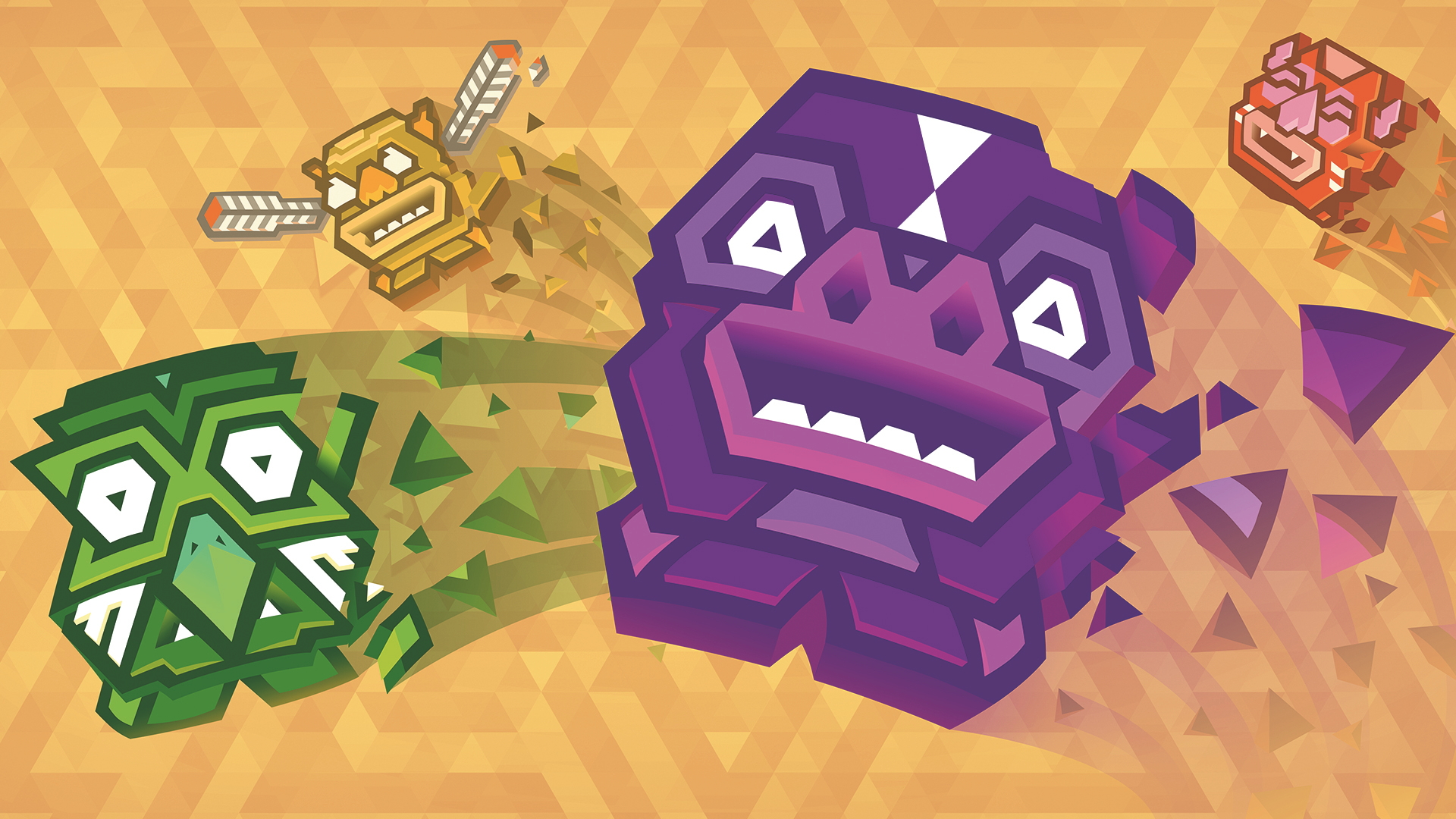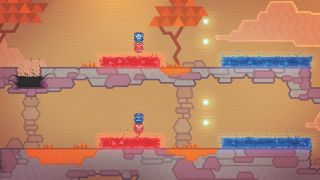
I usually loathe platformers. They’re stressful, they’re unforgiving, and I just really don’t like things that are hard. I always turn games down to the easiest setting, even if they make fun of me by calling it something like ‘This Is For Babies’ or ‘Why Don’t You Just Go Play Hopscotch Instead’. Kalimba is a platformer. Kalimba is stressful. Kalimba is unforgiving. Kalimba is very, very hard. It’s also the only game that I’ve ever given a perfect rating of ten out of ten.
In Kalimba, you play concurrently as two brightly coloured totem pole pieces – one on the top half of the screen, one on the bottom half – as you try to avoid various obstacles, black pits and roaming enemies. The pieces move together, and it’s this simple idea that causes 99 percent of your on-screen and off-screen issues. One piece jumps over a hole, the other piece jumps into spikes; one piece soars into the sky while the other tumbles into the abyss. It’s infuriating, and trying to get a perfect score on each level might come at the cost of breaking your controller into pieces.

Now, imagine that, but there’s another player involved. So it’s not just your own fumbling hands and mistimed jumps that drive you to rage – there’s a whole other person there to get everything wrong, and you can’t do anything about it.
Here’s why Kalimba is one of the best couch co-op games out there: it has several different modes, all of which are more difficult and infuriating than the last. You could play a relatively pleasant couch co-op game like Chariot, Castle Crashers or any one of the Lego games – or you could play a proper co-op game. A co-op game that doesn’t think you can do it, that thinks you’re weak. That, my friends, is Kalimba.

One of those modes requires the two players to use one controller. It’s not unique to Kalimba – you can do the same thing in Octodad – but it creates an extra level of difficulty that’s only for the most hardcore of masochists. It feels like you’re two dogs fighting over a piece of meat, except you’re also trying to walk across a rickety, ice-covered bridge at the same time. Imagine how much fun that is.
The thing is, as bloody difficult as Kalimba is, and as much as it really, really wants you to fail, it’s a wonderful thing to share with friends. The level design is smart but simple enough to understand at a glance, which is how the best platformers are made – you know what you’re supposed to do, but you just don’t know how to do it right. Having that instant connection between you, the game and your second player is something that can’t be replicated by any other medium.

It’s sometimes hard to bond with new people, but I’ve never managed to become friends as quickly as when I’m yelling, “USE THE GODDAMN JUMP BUTTON,” at someone I’ve just met. Obviously, it takes the right kind of person to respond well to the stresses and occasional hoarse yelling that couch co-op tends to encourage without breaking down, but that’s just how you figure out if they’re cool or not.
Sign up to the 12DOVE Newsletter
Weekly digests, tales from the communities you love, and more
Couch co-op comes out at parties because it brings a whole room of people together. Kalimba engages non-players in a game of their own, and it’s called knowing better than the players do. It’s so obvious! Jump-slide- jump-jump-dash. OBVIOUS. We’ve all done that sort of back-seat driving kind of audience participation, the sort that makes us feel smug and confident that we could do better. And then we get the controller, buoyed by that cockiness, and it all goes wrong.

I first played Kalimba co-op with OXM’s former editor, Matthew Castle. I really don’t think he wanted to play Kalimba with me, but we both loved it, and I had to complete it for review, so he didn’t have a choice. Honestly, after the first few levels, I was worried he was going to fire me. On what grounds? Can you be fired for being really bad at platformers? Probably not, but when your boss is flapping in rage at your terrible timing, you don’t think about these sort of things.
As much as he’d probably roll his eyes at the sentiment, I think it brought us closer (barf). It’s like those scenes in movies where two people who hate each other have to work together to save themselves from a sticky situation, except we didn’t actually hate each other in real life, just as partners in the game. I get that – it’s really quite maddening to execute all the moves perfectly only to have your doofus teammate mess up at the first hurdle. But I was trying, at least.

I’ve talked a lot about why couch co-op is frustrating, stressful and hard, but the real reason I love it is that tiny possibility, that glimmer of hope, that you might just complete a level with your second player. When you get that gold totem pole piece for executing a perfect level, that’s a shared accomplishment – you literally couldn’t have done it without that other person.
So yes, couch co-op is often terrible if you want a nice, relaxing time and not to punch your friends. It’s a bad idea to bring it out at a party that has the potential to turn into a hellish bloodbath. But couch co-op fosters a sense of intimacy between its players, and though the kind of intimacy that Kalimba enables is the kind that makes you hurl expletives at your partner, it’s one hell of an ice-breaker.
This article originally appeared in Xbox: The Official Magazine. For more great Xbox coverage, you can subscribe here.
Kate Gray is an award-winning writer with over a decade of experience in games journalism. Kate has bylines on a variety of websites which include 12DOVE, The Guardian, Buzzfeed, Kotaku, Vice, Rock Paper Shotgun, and others. Kate is now writing the good words over at Nintendo Life, and can still be found tweeting about nice things and taking lots of photos of food.
Most Popular



